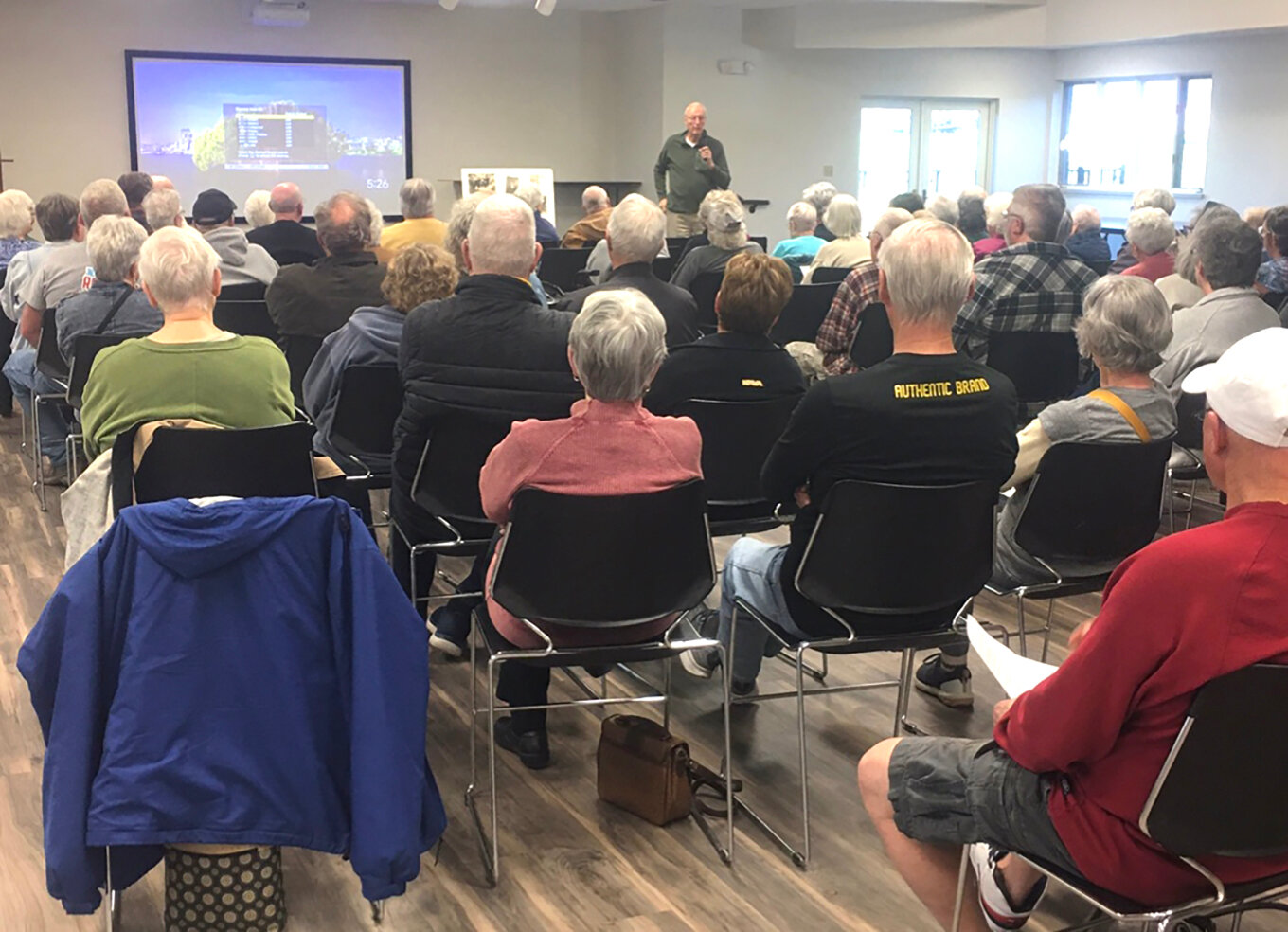Local historian's program sparks interest in historic stagecoach house restoration
Bob Cline's presentation draws crowd to kickstart fundraising efforts for West Liberty Heritage Foundation's restoration project
By Phyllis Owen Sterba
Index Historian
Approximately ninety people attended local historian Bob Cline’s West Liberty Heritage Foundation-sponsored history program on Sunday, April 7 at the West Liberty Community Center.
This program kicked off WLHF’s fundraising for the restoration of the recently acquired Beers and Company stagecoach house.
Their campaign goal is $250,000. Following a welcome by WLHF’s president Deb Wilson, Ken Donnelly introduced special guests: nonagenarians Leta Mae Howard Christensen, Marilyn Duncan Henderson, and Mary Pat Miller Brooke. Donnelly also recognized Pam Schnittjer, a local historian.
Cline showed a slideshow of West Liberty people, places, and things. Some slides went back as far as the 1930s. Featured photos included restaurants on Columbus Street: the Crystal, Elsie’s, and the India Café.
He shared photos of several homes in the area, including the Royal house on Calhoun. We saw a photo of the 1938 West Liberty Centennial parade float which Marilyn Henderson rode on.
Cline followed that with a special tribute to the Whitacre family of West Liberty. Following the slideshow, WLHF board member Scott Brooke along with Bill Koellner presented a slideshow and talk about Egbert Smith’s 1841 stagecoach house.
Brooke shared the history of how Smith and Beers and St. John came together to purchase the land the house would be on. He went on to explain how the WLHF board became involved many years ago with this project, and shared a few of the many, many ups and downs experienced in the last year prior to the moving.
Brooke concluded his part of the program with WLHF’s plans for the future. After Brooke’s talk, Cline showed a 1985 Chamber of Commerce short movie entitled Our Town, narrated by Bob Fulwider.
It was then decided, in the interest of time, to cut the program short and enjoy conversation and refreshments.
The two videos not shown, The History of the Strand, and Vietnam Vets, will hopefully be shown at the next in our series of history programs in the fall, date and time to be announced.
Brooke estimated that about twenty years have elapsed since the project was first brought to the attention of the WLHF by Marlin Ingalls, a historian from Iowa City.
Finally, the WLHF board last year put the plans into motion. The Ryan Trust matched a $50,000 grant which helped with the moving expenses.
History
Egbert T. Smith, a new settler from New York, with Mr. Beers and Mr. St. John, who already owned a stagecoach company elsewhere, acquired the land for the new inn in 1839.
A smaller inn and a tavern were already on the property but years later were destroyed. In 1839 a federal mail contract was awarded, and a second contract was given in 1841. At the time Smith came along, Burlington was still the capital of the Iowa Territory.
But in April of 1841, the capital was changed to Iowa City. Iowa did not become a state until 1846.
In order to build the much larger inn, Smith traveled to Cincinnati, Ohio where most of the building materials (doors, windows, and framing) were easily available.
These were shipped by steamboat to Bloomington (later named Muscatine), then hauled by oxen to the building site.
The stones for the foundation were hauled from a nearby quarry of Upper Silurian limestone on the headwaters of the Wapsie, known locally as the Hickory Grove Quarry. To accomplish this a road had to be opened and the sloughs and streams bridged.
It was a laborious task and took the greater part of one season. The Smith family moved into the house in 1841. Under the siding, the walls were bricked up more than halfway throughout.
This was done not only to protect against intruders but also for insulation. The house contained tens of thousands of bricks.
These bricks were burned about where the windmill stood on the nearby Amos Whitacre farm. The clay there was “the best to be found”.
The joists, rafters, and framework were all hand-hewn from the abundant stands of white oak trees in the timber surrounding the property, by a local cabinetmaker named Mr. Cole.
The house was roofed with cedar shake shingles. Architecturally, the house was a combination of colonial and federal eras, with a twist of classic.
At one time, the house had an octagonal glass cupola used to adorn the center at the roof’s crest. It held a lantern so the stagecoach driver could see where the house was from afar. It was later removed.
As the house never had a central heating system, it was heated with wood-burning stoves. It had four fireplaces, two each on the first and second floors, and a three-story cherry staircase.
In the front yard, there were two large mounds which stagecoaches used to pull up next to in order to disembark passengers without them having to jump out.
Previous owner Mary Smith Jensen’s daughter, Laura Jensen Elliott, related that while mowing years ago, the mower unknowingly hit an old wagon wheel which was embedded in the ground on the edge of the driveway. Elliott said arrowheads and a sign saying “Maple Grove Lane” were also found.
During the Civil War, slaves were hidden in the smaller inn. Many visitors to the inn carved their initials into the wood in the attic. Egbert Smith stayed in the area less than fifteen years. He’d purchased about 4000 acres of nearby farmland while he was here.
Now a widower, he relocated to California. The railroad arrived in the area in 1855, so the inn was closed. It became a private residence.
Planning the Move, 2023/24
Goodwin House Moving of Washington was hired in early 2023 to move the stagecoach house from its home on Highway 6 to Heritage Park in West Liberty. The house would be Goodwin’s second heaviest load ever, weighing over 100 tons.
Their only move heavier was a plantation in Louisiana. As Brooke said, “Our first goal was just to get it here (to Heritage Park). Get it here in one piece and get it on the foundation. We had a really, really narrow window to get it moved.
We had to get her moved on a certain timeline because of the weather and ground conditions, and everything else, because it had to cross a couple of farm fields”.
Part of the reason it was moved through cornfields was to avoid power lines.
Moving the three-story 3600 square foot building took a lot of coordination between landowners, utility companies, the Iowa DOT, the railroad, the county, the city of West Liberty, and more. There were pages and pages of checklists that the WLHF went over each month.
Portions of Highway 6 would need to be closed in both directions for the move, and the few power lines that had to be taken down were quickly put back up, so as to not inconvenience any homeowners along the route and to allow for the house to move safely to its new home at Heritage Park.
The board experienced many ups and downs during 2023. By spring of 2023, they were still on track for an early 2024 move. In August, however, Brooke met with City Hall.
Unfortunately, the ‘fickle finger of fate’ intervened, potentially causing a stall in the project. There were some zoning issues which took over a month to resolve.
This delayed the site approval, inspection, and building permit. In the end, the building did end up being placed closer to Elm Street rather than the trail, due to the high-water table and the lower elevation near the trail. The problems with the zoning delayed the foundation pouring.
In early November, Brooke called an emergency meeting of the board to share that apparently the moving company did not know about the brick nogging in the walls, even though they’d been told several times. The nogging would increase the weight and difficulty moving the house.
It also would increase the cost to two to three times the original amount. The board discussed several options, one of which was walking away from the project.
In the end, however, they voted unanimously to do the necessary nogging work themselves. WLHF board members and community volunteers met up on a couple of weekends in December and January and pulled about two tons of bricks from the walls, then palletized them.
The bricks were then moved to a WLHF storage property for future use. Fortunately, the excavation at Heritage Park had not yet occurred at the time this urgent situation regarding the nogging arose.
Excavation was completed, and the foundation was poured in mid-November. In mid-January Brooke again contacted the board, asking if maybe we needed a Plan B.
The back-to-back blizzards had just occurred, and even though we’d taken what steps we could to prevent snow from coming into the stagecoach house, the ground was not frozen yet.
Additionally, due to the snow, we’d lost precious time we could have been in the house readying it for the move. A Plan B was decided on, but fortunately did not need to be utilized.
By mid-February the ‘problem’ corner of the house had been stabilized, as were the inside walls. Plywood was put on all the windows, inside and out. Goodwins arrived on site and began their prep work.
A moving date was announced, and the press notified.
Conditions were ideal on Monday, February 26: clear sunny skies, 60 plus degrees by afternoon, and little wind.
The house was moved flawlessly in a little over three hours. Onlookers were found on every corner along the route, and a large crowd gathered at Heritage Park to watch the house pull in.
Future Plans
Now that the building is in Heritage Park, the next step is to raise funds for the restoration. Brooke says no specific timeline is in place yet.
Once restoration is completed, the building will be opened as a public museum. The plan is to do one floor at a time, and to do so slowly and meticulously. Brooke emphasized that the building will be restored, not modernized.
Currently, Matt Ruess is building a 2’6” block platform on the floor of the basement for the chimney to sit on. The building still has most of the original hardware, doorknobs, doors, shutters, and mantles, which Brooke said will make the restoration easier.
He is hopeful that the original cupola can be replaced. “The miraculous thing about it is that over all this time, it was not modernized much,” Brooke said.
He continued, “It’s basically a time capsule”. He says, “We had future politicians and everybody else staying here on their way. It’s just too important a structure to simply let it fade away”.
Bill Koellner, a former WLHF board member, said in 2015, “It’s a tremendous opportunity to take a snapshot in time of the 1840s. We see it as a real piece of history of the growth of the state of Iowa over the years”.
During the stagecoach era, the house served as an inn for travelers, a swing station to switch horses, a tavern, mail station, and an all-around resting point for the weary.
Koellner continues, “The stagecoach house has the potential of being developed, restored, and becoming a tourist opportunity that would bring people off the interstate to see something historical”.
Donations can be mailed to WLHF, PO Box 352, West Liberty, Iowa 52776. West Liberty
Heritage Foundation board members are Deb Wilson, President, with members Scott Brooke, Cliff McFerren, Cindy Wilson, Jim Carey, Mike Duytschaver, Eric Christensen, Phyllis Sterba, and Frank Wagner.
Comments




